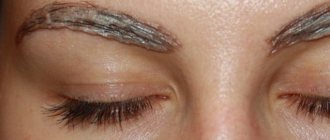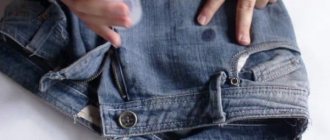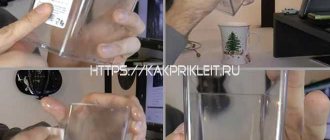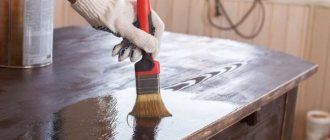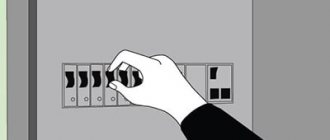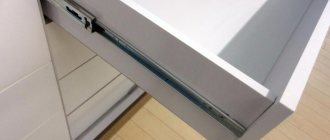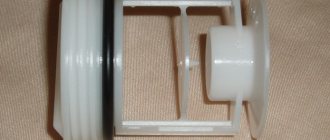When you plan to renovate a house, the question arises of how to remove old finishing materials from the surface and prepare it for decoration. Very often there is a need to remove paint from wood.
Hard materials such as concrete or cement are not as difficult to remove as wood. Wooden surfaces are soft and easy to damage. Before starting repair work, familiarize yourself with the ways in which you can remove paint from them without damaging the material.
[contents]
Getting started, preparing tools
To remove paint from wood, you need to determine the scope of work. You should find out how many layers were applied previously. The type of paint also plays a role, since the degree of adhesion, and therefore the ease of performing the work, depends on this.
Factors to take into account:
- one layer of finishing does not have to be removed, it is sanded, then a new one is applied;
- you should find out what type of wood the structure is made of, as it may be difficult to clean and further process;
- if the product needs to be painted in a lighter shade, the top layer must be completely removed;
- determine the type of structure (stationary, portable), since it is not always possible to use aggressive chemicals indoors; some things are taken out into the fresh air for treatment.
When choosing a way to remove old paint from a wooden surface, they also pay attention to the technology for its implementation, while choosing tools and materials:
- electric drill;
- wash;
- spatulas of different widths;
- sandpaper;
- hair dryer;
- lint-free rags;
- brushes with metal bristles;
- Angle grinder.
You need to wear protective equipment when working. You will need a respirator or mask (the choice is made when deciding how to remove old paint: chemically or mechanically), gloves, and goggles.
Important: If the treatment will be carried out outside, you need to check the weather for the coming days. Other important factors that you should find out about in advance: the age of the foundation, the operating conditions of the structure.
Preliminary preparation and tools for work
Wood can serve for several decades as a building material only if it is provided with proper ongoing care. When wood is exposed from old paint, it must be treated with protective agents. Otherwise, the new coat of paint applied will not last long.
Before applying the painting material, it is important to consider:
- age of wood;
- wood species;
- the thickness of the previous paint layer (single-layer coating does not always need to be removed);
- the shade of the old paint and its texture;
- service life of the previous layer of paint.
How to choose high-quality and durable LED light bulbs for your home? We have the answer!
Read about the advisability of purchasing an anti-vibration mat for your washing machine at this address.
You need to prepare the tools for work in advance:
- putty knife;
- construction hair dryer;
- Bulgarian;
- Grinder;
- chemical-based remover;
- rags;
- protective equipment (gloves, goggles, respirator).
READ ALSO: Corrugated roofing sheeting at a low price from the manufacturer
Paint Removal Options
All technologies are divided into 4 groups. If you need to choose a way to remove old paint from wood, you should consider:
- Mechanical damage: use simple tools, but only old finishes or multi-layer coatings can be scraped off with this method;
- a method based on the use of a heat source: removal of paint and varnish material is carried out by exposure to elevated temperatures (a powerful household or construction hair dryer, gas burner);
- chemical: the old layer can be washed off with special compounds;
- sandblasting: removal of paint from wood (doors, skirting boards, wall panels and other products) is carried out using equipment, with an intense abrasive effect.
Mechanical method
The surface cleaning technique is based on the use of sandpaper, a stiff brush (made of metal) or a power tool - drill, angle grinder. In this case, the surface layer is removed.
This option is suitable for cases when choosing a technology for removing paint from a wooden surface, provided that the coating is thin.
Processing the product with sandpaper or a scraper (grater)
Consider abrasives of different grain sizes. The processing technique is the same: with monotonous movements (circular or reciprocating) the old layer of finishing is cleaned.
You need to start with coarse sandpaper. Then sand with fine-grained paper.
Cleaning the surface with an angle grinder (angle grinder)
You need to learn how to remove old paint from wood safely for the entire structure. Features of the method:
- a sander is used when a coating of significant thickness is applied;
- Angle grinders are used to remove lower layers of finishing;
- when performing the processing procedure, the average operating speed of the device is set;
- prepare a disk with an abrasive surface (petal).
Using a drill
The high speed of implementation of the method is noted. The tool must be positioned perpendicular to the surface being processed. You can use attachments that increase grinding efficiency.
A drill is convenient to use if you need to remove old paint from areas of complex configuration or wooden surfaces of small parts.
Removing the coating with a wire brush
When using a cord brush (with metal bristles), the likelihood of damaging the base increases. For this reason, when you need to choose a method for removing paint from wood, consider this option last, and only as a backup. After this, you often have to sand the wood.
Thermal method
Involves exposure to high temperatures. Options:
- hair dryer: does not always provide the desired effect (weak effect);
- gas burner (note a high risk of a fire hazard);
- iron and foil, after applying the method, use the mechanical impact technique.
Chemical method
Before you begin removing the finishing layer, you need to ensure air flow into the room (if it is not possible to take the structure outside). Also protect surrounding objects with polyethylene.
Features of choosing and using wood paint remover:
- consider gel-like substances and liquids, the first option works faster and better;
- if wooden surfaces are quickly damaged, choose non-aggressive substances;
- The remover may not be suitable for removing multi-layer coatings.
Sandblasting: grinding with fine abrasive
If you do not have experience and skills in working with equipment, choose another method to clean old paint.
The difficulty of using sandblasting technology lies in the high risk of damage to wood.
The method is based on the delivery of solid particles to the coating using a jet of water. Its main advantage is a completely ready surface for further work with fresh composition.
How to remove paint from furniture
If you have old furniture that is a pity to throw away, but whose appearance has long been no longer consistent with the original one, update it.
The most common way to update furniture is painting. But in order for the paint layer to adhere well, the surface must be properly prepared by removing the previous paint. You need to know how to remove paint from furniture, since when painting on an uncleaned surface, the result will not last long. Fresh paint must apply evenly, otherwise it will peel. Therefore, when preparing furniture for renovation, it is important to carefully remove old paint. Of course, when preparing, you should not forget about cleaning the furniture from dirt and dust. This can be done with a special vacuum cleaner or furniture detergents.
Which option should you choose?
When deciding how to remove old paint from wood, the following factors are taken into account:
- to reduce costs, a mechanical method is chosen, but this process is lengthy, and it will not be possible to completely clean the multilayer coating without damaging the base;
- speeds up the procedure for removing the coating using a chemical method, but takes into account the possibility of ventilating the room or transporting the processed product outside;
- Sandblasting at home is not used without equipment and experience;
- the thermal method is one of the available ones; if there is no hair dryer, a household hair dryer is used (provided that it is characterized by high power, since this promotes rapid heating of the surface), a gas burner and even an iron with foil can be used, but in both cases there is a risk the formation of dark spots on wood increases many times over.
How to remove paint from furniture
If you have old furniture that is a pity to throw away, but whose appearance has long been no longer consistent with the original one, update it. The most common way to update furniture is painting. But in order for the paint layer to adhere well, the surface must be properly prepared by removing the previous paint. You need to know how to remove paint from furniture, since when painting on an uncleaned surface, the result will not last long.
Fresh paint must apply evenly, otherwise it will peel. Therefore, when preparing furniture for renovation, it is important to carefully remove old paint. Of course, when preparing, you should not forget about cleaning the furniture from dirt and dust. This can be done with a special vacuum cleaner or furniture detergents.
Subtleties of removing different types of dyes
Will be considered:
- Acrylic compositions. They are removed chemically. It is also recommended to use the method of exposure to a heat source, after which it is proposed to remove the softened layer.
- Oil compositions. They can be wiped off with a chemical remover. The method of mechanical action is also effective (multilayer old coating is removed with a spatula).
- Water-based compositions. Solvents are ineffective in this case. The mechanical option is considered first.
Features of removing old paint from a wooden surface at home
There are no special secrets in removing old material from a wooden surface. Builders recommend adhering to some rules:
- If you want to paint a part that has been painted once, then you do not have to strip off the paint material from it - you can simply cover the surface with a second layer of paint.
- In the case where there are many layers of paint, it is necessary to remove these layers with sandpaper.
- If the wood was painted in a fairly dark color, and you want to change the color in favor of lighter tones, you will also need to erase the layers of the old composition in order not to spoil the final result.
Preliminary preparation and tools for work
How can you clean wood? Tools for work are selected depending on the processing method you will use. For example, for the thermal method you cannot do without a gas burner or a hair dryer and a spatula. Using a mechanical method of removing old material, you need to use a spatula, as well as a respirator and goggles.
With the chemical method, everything is a little more complicated, because you first need to prepare the oilcloth in order not to smear the floor; during the work, they use a spatula and a brush.
Homemade wash
It is not difficult to clean objects from paint and varnish material using improvised means. Prepare homemade liquids for removing paint from wood. Recipe:
- You will need: caustic soda (1 kg), the same amount of chalk, slaked lime (0.9 kg), liquid (4.5 l). The ratio of components is maintained, but the proportions can be changed.
- Dilute the soda with water, heat the solution to +60°C.
- Add chalk and lime to the mixture and mix until a uniform consistency is formed.
How to quickly remove?
There are several ways to remove paint from a wall, each of which differs in the complexity of execution, the necessary tools, and the presence of certain knowledge and skills.
Mechanical methods
The mechanical cleaning method involves the use of the following tools:
- painting knife;
- putty knife;
- chisels;
- scraper;
- axe.
Algorithm of actions:
- Prepare the tool. It is necessary to check that the blade is well sharpened and tightly fixed to the handle.
- Place the tool at an acute angle to the wall, and make many cuts with short strokes (the more, the better).
- Moisten the wall generously with water from a spray bottle.
- Scrape or knock down the swollen layer of paint.
Work with hand tools is carried out only in protective glasses, gloves and thick clothing. Otherwise, there is a high risk of injury from flying pieces of old decorative coating.
Heat treatment
The simplest, fastest and most effective way to clean a wall is to heat the decorative coating with a hairdryer. Everything is very simple: the paint on the wall is burned with a stream of hot air from a hair dryer, and then very quickly removed with a spatula or scraper.
In order for the cleaning process to go faster, it is carried out simultaneously by two people (one burns, the second immediately removes the paint).
Limitations of using the thermal method:
- it is problematic to use the burner in apartment buildings;
- It is unacceptable to burn the wall without using personal protective equipment (during the burning process, the paint releases elements hazardous to health);
- absolutely not suitable for removing decorative coatings from metal and plastic surfaces;
- It is prohibited to use the thermal method in rooms without ventilation.
In cases where it is not possible to use a construction hair dryer, it can be easily replaced:
blowtorch (it is important to follow fire safety rules); iron and foil (cover the painted surface with foil and then heat it with an iron); household hair dryer (inferior to a construction hair dryer only in terms of service life).
Electromechanical
You can remove paint from a concrete wall as quickly as possible using an electromechanical method. Simply put, a variety of power tools are used to clean walls:
- A grinder with a wide grinding wheel (it is recommended to use a wheel with an abrasiveness of at least 40). You can also use a grinder with a special attachment in the form of a steel wire brush.
- Drill with a paint remover attachment. The nozzle is a structure of three chains, each of which has thirteen links. During operation, the chains break the decorative coating (flying off in pieces) with a minimum amount of dust.
- Drill with crown bit. The process of cleaning a wall with such a power tool is quick, with minimal risks of injury and dust formation. The only thing that needs to be taken into account is the high cost of the nozzle and the need for its frequent replacement.
Work using power tools is very rarely used on wooden surfaces (active rough cleaning disrupts the structure of the wood).
Use of chemicals
The chemical method of removing paint from a wall involves the use of special liquid or gel removers and solvents:
- White Spirit,
- acetone.
Work with chemicals is carried out only in a very well-ventilated area and using personal protective equipment (gloves, respirator, goggles).
Basic rules for applying chemical solvents
- liquid compositions are applied using a spray gun, gel solvents - with rollers or brushes;
- before cleaning the wall, you must wait a certain period of time (indicated by the manufacturer on the label);
- remove the softened paint using a spatula or iron brush;
- The wall cleaned with chemical reagents is additionally treated with an acidified solution (water with the addition of citric acid or vinegar).
If signs of illness (dizziness, nausea) appear during the use of chemicals, work must be stopped immediately and the premises must be left.
Basic rules and recommendations
To avoid mistakes, you need to learn more about the features of cleaning wood from paint and varnish material:
- before use, the chemical must be applied pointwise to the surface in an inconspicuous place to check how the remover affects the wood;
- the chemical is applied to the entire area at once;
- finishing liquids should not last longer than 2 hours, as this will damage the base;
- It is not recommended to pour the remover into plastic containers (it can ruin it);
- when working with heat sources, do not overheat the base;
- when the mechanical method is chosen, the forces applied should be controlled, since the wood is easily damaged.
Thus, each method of removing paints and varnishes has advantages and disadvantages. They are used under various conditions. You cannot use an inappropriate method, because... at the same time, the risk of developing irreversible processes increases (furrows, cinders, differences in surface levels at different points of the structure remain).
Removal Methods Not Recommended
Some craftsmen use a thermal method to remove old coating by exposing the treated area of the product to open fire. Using this method is highly discouraged due to the increased risk of possible fire.
In addition, when processing products from various types of wood using this method, the material dries out and its internal structure is damaged, which significantly reduces the strength of the product and its service life.
Some types of wood during this treatment can release resins that are easily flammable or create a film on the product. This film will significantly reduce adhesion, and may even prevent you from applying a new layer to the surface.
When choosing methods for removing old coating, the main thing is to follow the rules of personal safety, use protective equipment and follow safety precautions when working with electrical appliances.
Varieties of composition for washing
All modern removers can be divided into two categories - special and universal formulations. Special removers for wood paints and varnishes can soften only certain types of varnish and paint materials. For example, there will be removers for textured, alkyd, oil and other coloring mixtures.
Special preparations for washing will be more effective compared to universal chemical-type solutions, because their production takes into account the characteristics of a certain type of paint and varnish material. Special washes have a higher price than universal formulations. Such stripping solutions are suitable for removing any type of old paint from wood, both water-based and containing some kind of organic solvents.
Preparations for removing old paint and varnish material can be divided according to the form of release, and they can be liquid, dry and jelly-like (the latter will need to be dissolved). It is necessary to choose one or another preparation for coloring based on the characteristics of the coating and the circumstances. For example, jelly-type paste is perfect for vertical wood surfaces because they adhere well to the material and do not run off. But liquid washes will be the best option for cleaning painted horizontal surfaces, as well as for various small parts and elements with fine threads. If it is important to treat expensive pieces of furniture, and especially those covered with veneer, it is advisable to give preference to a remover that can be removed with white spirit. If the cleaning fluid is not removed in time, the wood fibers will begin to swell.
Before choosing one or another composition for removing paint, it is important to carefully read the instructions, which must be on the label, packaging, or you can consult with a sales consultant. Moreover, it is necessary to take into account that not every type of remover is suitable for application to the surface of wood. If the purchased remover of old paint is specifically for wood, then this should be indicated on the packaging.
Features of cleaning the floor from paint
Removing paint from the floor is a seemingly simple task, but this type of work still has some peculiarities. For example, it is important to follow safety precautions.
- When working with heating devices, you need to be careful not to get burned. Also, do not inhale the vapors that are formed when the paintwork is heated. A respirator must be used.
- It is also advisable to use protective equipment when working with substances used in the chemical method of removing coatings. Gloves and a respirator will help protect your skin and respiratory tract.
Respirator
- When removing the coating using mechanical methods, a large cloud of dust is often formed, which is also not recommended to inhale - respiratory diseases can develop. In addition to a respirator, it is recommended to use goggles to protect your eyes.
- You should always follow the instructions for using chemicals and tools.
- It is better to first test the selected paint removal method on a small area of the floor, since in certain cases one or another method may be ineffective.
Old paint stays strong
How to avoid damaging the door leaf?
The wooden surface has a characteristic texture and is susceptible to harsh mechanical stress.
When working with natural materials, the following points should be taken into account:
the spatula should be directed at an angle to the surface; movements should be in the direction of the fibers; to process difficult areas, it is necessary to use a special tool with a wedge-shaped nozzle; Particular care should be taken when working with soft wood, as well as with decorative elements that are milled.
In addition to updating the paint, you should pay attention to the condition of the fittings. If necessary, replace or restore metal elements
How to remove old paint
In addition to the products described above, special chemical removers are often used, which contain formic acid, dimethyl chloride, and other organic substances. Such reagents differ in the rate of decomposition process, and therefore they can be considered almost harmless.
Chemical wash works well with water-based paint - if the product is covered with one or two layers, it will be easy to wash off with store-bought reagents. There are several ways to remove paint coating using products that you can even make yourself. The water-based emulsion can be easily and simply removed using wallpaper glue or paste. The entire surface of the product should be coated with adhesive and newspaper should be glued. After drying, remove the paper with a spatula, and along with it, the layer of paint will come off the wood.
Using mechanical methods of removing paint, you can do everything quickly, and you should give preference to a drill with a special attachment, which can be used as a brush with metal bristles, which does an excellent job of processing a multi-layer water-based coating, because it cannot be removed with a spatula. The only drawback of this method will be a lot of dust formation in the apartment, which means that when carrying out such work in the kitchen, you need to cover all the furniture with film.
